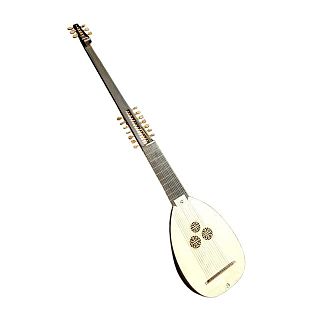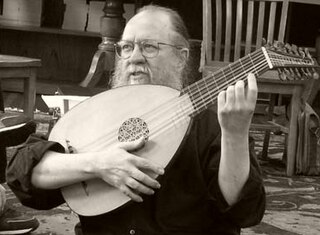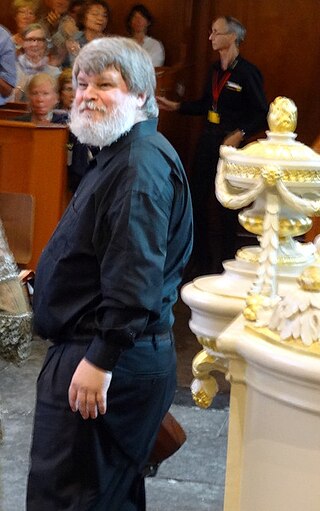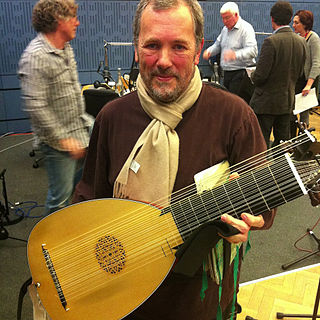Related Research Articles

A lute is any plucked string instrument with a neck and a deep round back enclosing a hollow cavity, usually with a sound hole or opening in the body. It may be either fretted or unfretted.

The theorbo is a plucked string instrument of the lute family, with an extended neck that houses the second pegbox. Like a lute, a theorbo has a curved-back sound box with a flat top, typically with one or three sound holes decorated with rosettes. As with the lute, the player plucks or strums the strings with the right hand while "fretting" the strings with the left hand.

Patrick O'Brien was an American guitarist and lutenist born in New York. He was a recording artist, but was best known as a pedagogue in the field of early plucked instruments in America, and an expert in musicians' hand anatomy. He has worked with musicians on many instruments, reworking their technique around repetitive stress injuries and breakdowns of coordination.

Julian Alexander Bream was an English classical guitarist and lutenist. Regarded as one of the most distinguished classical guitarists of the 20th century, he played a significant role in improving the public perception of the classical guitar as a respectable instrument. Over the course of a career that spanned more than half a century, Bream also helped revive interest in the lute.

William Lawes was an English composer and musician.

The Taverner Choir, Consort and Players is a British music ensemble which specialises in the performance of Early and Baroque music. The ensemble is made up of a Baroque orchestra, a vocal consort and a Choir. Performers place emphasis on a historically informed performance practice and players work with restored or replicated period instruments.
Hille Perl is a German virtuoso performer of the viola da gamba and lirone.
The archlute is a European plucked string instrument developed around 1600 as a compromise between the very large theorbo, the size and re-entrant tuning of which made for difficulties in the performance of solo music, and the Renaissance tenor lute, which lacked the bass range of the theorbo. Essentially a tenor lute with the theorbo's neck-extension, the archlute lacks the power in the tenor and the bass that the theorbo's large body and typically greater string length provide.
A tiorbino, a small theorbo, is a rare stringed instrument, a type of long-necked lute resembling a theorbo but significantly smaller and pitched an octave higher. The tiorbino was created in the late 16th century and was played in the 17th century, as in the 1622 composition Capricci a due stromenti cioe tiorba e tiorbino e per sonar varie sorti de balli.. by Bellerofonte Castaldi. The tiorbino was then abandoned, only to return in the late 20th century with the renaissance of interest in early music.
Giovanni Girolamo Kapsperger was an Austrian-Italian virtuoso performer and composer of the early Baroque period. A prolific and highly original composer, Kapsberger is chiefly remembered today for his lute and theorbo (chitarrone) music, which was seminal in the development of these as solo instruments.

Paul Raymond O'Dette is an American lutenist, conductor, and musicologist specializing in early music.

James Tyler was a 20th-century American lutenist, banjoist, guitarist, composer, musicologist and author, who helped pioneer an early music revival with more than 60 recordings.
The Harp Consort is an international early music ensemble directed by Andrew Lawrence-King, specialising in Baroque opera, early dance-music, and historical World Music.
Terrell Stone is an American lutenist and recording artist. He is a longtime resident of Italy, where he holds the position of a Professor of lute.

Nigel North is an English lutenist, musicologist, and pedagogue.
Timothy Allen Burris is an American lutenist.
Jakob Lindberg is a Swedish lutenist, performing solo, in small and large ensembles, and also directing operas, using instruments of the lute and guitar families. He is known for the first ever recording of the Complete Solo Lute Music of John Dowland as well as for recording music never before recorded, with repertoire dating back to the Renaissance period.

Richard Stone is an American lutenist, music director, educator and music editor. He performs on lute and theorbo as a soloist and accompanist; he and Gwyn Roberts co-founded and co-direct Tempesta di Mare, The Philadelphia Baroque Orchestra; his musical editions are published by AR Editions and Prima la Musica; and he lectures and teaches lute, theorbo, continuo and performance practice for singers and instrumentalists at the Peabody Conservatory of The Johns Hopkins University.

Massimo Marchese is an Italian musician, lutenist, theorbist and recording artist.
Maria Evangelina Mascardi is an Argentinian lutenist, guitarist, and theorbist, resident of Orte in Italy, and a professor of lute at the Conservatorio Antonio Vivaldi in Alessandria, Italy.
References
- ↑ "Sandwell Youth Orchestra - Where are they now?" . Retrieved 7 September 2009.
- ↑ "Website" . Retrieved 22 February 2014.
- ↑ "Shakespeare's Lutenist", Medieval Music & Arts Foundation. Retrieved 2014.